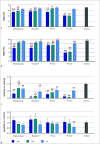In-Vitro Effect of Manuka Honey / Propolis Toothpastes on Bacteria and Biofilm Associated with Caries and Gingivitis
- PMID: 40146163
- PMCID: PMC11966148
- DOI: 10.3290/j.ohpd.c_1910
In-Vitro Effect of Manuka Honey / Propolis Toothpastes on Bacteria and Biofilm Associated with Caries and Gingivitis
Abstract
Purpose: To investigate the antibacterial and anti-biofilm effects of two Manuka honey toothpaste formulations containing propolis (Manuka prop) or fluoride (Manuka F), in comparison with the toothpaste base (TP con) and a commercial toothpaste (TP com), on oral bacteria and biofilm.
Materials and methods: The minimum inhibitory concentration (MIC) of the formulations and controls were tested against five oral bacterial species. Both the effect on a multispecies dental biofilm precultured for 3.5 days as well as the inhibition of de-novo biofilm formation up to 24 h were investigated. Test substances at concentrations of 20%, 10% and 5% were applied to preformed biofilm for 1 min. The reduction in colony-forming units (cfu), metabolic activity, and biofilm mass were determined. Similarly, the test substances were applied to surfaces for 30 min before bacteria and media were added. The reduction of a tetrazolium dye (MTT assay) was used to assess cytotoxicity on gingival fibroblasts.
Results: The MIC values of all toothpaste formulations including TP con were very low with the highest MIC of 0.04%. In precultured biofilms, both the number of colony forming units (cfu) and metabolic activity decreased following addition of any toothpaste. The greatest reductions of cfu were found after addition of 20% TP com (by about 6 log10) and after 20% Manuka prop (by about 2.3 log10). However, the biofilm mass was not reduced. Coating the surface with toothpaste formulation, the cfu in the newly formed biofilm decreased in a concentration-dependent manner, with TP com being most active. Both 20% of Manuka prop and Manuka F reduced the cfu counts more than the TP con at 24 h. The toothpaste formulations affected the viability of gingival fibroblasts in a concentration-dependent manner, with no differences observed among the formulations.
Conclusion: The Manuka-honey containing toothpastes might be an alternative to toothpaste containing conventional chemical agents. Further research is needed to clinically examine the effect on caries and gingivitis prevention.
Keywords: oral bacteria; oral hygiene; supragingival biofil.
Figures



Similar articles
-
Antibacterial Efficacy of a Propolis Toothpaste and Mouthrinse Against a Supragingival Multispecies Biofilm.Oral Health Prev Dent. 2015;13(6):531-5. doi: 10.3290/j.ohpd.a34372. Oral Health Prev Dent. 2015. PMID: 26106649
-
Effect of experimental toothpaste containing hydroxyapatite nanoparticles and propolis, with and without fluoride, on the microcosm biofilm and enamel demineralization.Biofouling. 2023 Mar;39(3):339-348. doi: 10.1080/08927014.2023.2217689. Epub 2023 Jun 1. Biofouling. 2023. PMID: 37259560
-
Application of biosurfactants and chitosan in toothpaste formulation.Colloids Surf B Biointerfaces. 2019 Sep 1;181:77-84. doi: 10.1016/j.colsurfb.2019.05.032. Epub 2019 May 15. Colloids Surf B Biointerfaces. 2019. PMID: 31125921
-
The influence of antibacterial toothpastes on in vitro Streptococcus mutans biofilm formation: a continuous culture study.Am J Dent. 2014 Jun;27(3):160-6. Am J Dent. 2014. PMID: 25208365
-
The Anticaries Efficacy of a 1.5% Arginine and Fluoride Toothpaste.Adv Dent Res. 2018 Feb;29(1):93-97. doi: 10.1177/0022034517735298. Adv Dent Res. 2018. PMID: 29355420 Review.
References
-
- <styled-content>Belibasakis GN, Belstrom D, Eick S, Gursoy UK, Johansson A, Kononen E. Periodontal microbiology and microbial etiology of periodontal diseases: Historical concepts and contemporary perspectives. Periodontol 2000 2023;Jan 20. doi: 10.1111/prd.12473. Epub ahead of print. PMID: 36661184.</styled-content> - PubMed
-
- Cvikl B, Lussi A, Gruber R. The in vitro impact of toothpaste extracts on cell viability. Eur J Oral Sci. 2015;123:179–185. - PubMed
MeSH terms
Substances
LinkOut - more resources
Full Text Sources
Medical
Molecular Biology Databases

